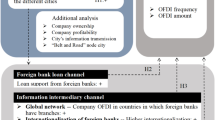Abstract
The paper highlights the export-diversifying impact of foreign direct investment (FDI) in a developing country. FDI may lead to export diversification in the host country if it positively affects the export intensity of industries that have a low share in world exports. Indirectly, FDI may encourage export diversification through spillover effects: that is, the presence of FDI in an industry may increase the export intensity of domestic firms. The empirical results for the Indian economy in the post-liberalisation period show that FDI from the US has led to diversification of India's exports, both directly and indirectly. However, Japanese FDI has had no significant impact on India's exports.
Similar content being viewed by others
Notes
It has been found that resource-seeking, efficiency-seeking and export-oriented FDI would promote exports, whereas market-seeking FDI and technology-seeking FDI may not be catalysts to export growth.
See Dunning (1988).
For criticisms see Dunning (1981), Hill (1988, 1990).
Defined as the sector consisting of industries whose average share in world exports in the period 1985–1990 is more than 1%.
Defined as the sector consisting of industries whose average share in world exports in the period 1985–1990 is less than 1%.
See Kumar (1994) for empirical evidence.
See Dunning (1988).
Some economists have, however, criticised this distinction and have attributed this difference to the ‘vintage effect’, that is, the stage of industrialisation.
Following transaction costs analysis, FDI will dominate as the mode of foreign market entry when transaction costs through the external market are high and internalisation is preferred, whereas licensing will be the preferred mode in cases where transaction costs through the market are low. In this view, FDI and licensing are alternatives or substitutes. The interaction between FDI stake and licence payments affecting exports may therefore be negative.
This is contrary to Kojima's (1973) hypothesis. However, the results are consistent with those found by Encarnation (1999) for the 1970s and 1980s.
A probit model has also been estimated, but the results are found to be qualitatively similar to the tobit model, and therefore are not reported. An implication of the similarity of results is that in the non-traditional sector the firm's initial decision to engage in exports does not vary much from its decision to export more.
References
Dunning, J. (1981) ‘Explaining the international direct investment position of countries: towards a dynamic or developmental approach’, Weltwirtschaftliche Archiv 116: 365–379.
Dunning, J. (1988) ‘The eclectic paradigm of international production: a restatement and some possible extensions’, Journal of International Business Studies 19(1): 1–31.
Dunning, J. (1994) ‘Transpacific FDI and the Investment Development Path: the Record Assessed’, University of South Carolina, Essays in International Business, No. 10.
Encarnation, D.J. (1999) Japanese Multinationals in Asia: Regional Operations in Comparative Perspective, Oxford University Press: New York.
Hill, H. (1988) Foreign Investment and Industrialization in Indonesia, Oxford University Press: Singapore.
Hill, H. (1990) ‘Foreign investment and East Asian economic development’, Asian-Pacific Economic Literature 4(2): 21–58.
Keesing, D.B. and Lall, S. (1992) ‘Marketing Manufactured Exports from Developing Countries: Learning Sequences and Public Support’, in G. Helleiner (ed.) Trade Policy, Oxford Clarendon Press.
Kodama, F. and Honda, Y. (1986) ‘Research and development dynamics of high-tech industry: toward the definition of high technology’, Journal of Science Technology and Resource Management 1: 65–74.
Kojima, K. (1973) ‘A macroeconomic approach to foreign direct investment’, Hitotsubashi Journal of Economics 14: 1–21.
Kojima, K. (1978) Direct Foreign Investment: A Japanese Model of Multinational Business Operations, Croom Helm: London.
Kojima, K. (1982) ‘Macroeconomic versus international business approach to direct foreign investment’, Hitotsubashi Journal of Economics 23: 1–10.
Kumar, N. (1994) ‘Determinants of export-orientation of foreign production by US multinationals: an inter-country analysis’, Journal of International Business Studies 25(1): 141–156.
Kumar, N. and Siddharthan, N.S. (1997) Technology, Market Structure and Internationalisation, Routledge: New York and London.
Lall, S. and Sharif, M. (1983) ‘Foreign ownership and export performance in the large corporate sector in India’, Journal of Development Studies 20(1): 56–67.
Pailwar, V. (2001) ‘Foreign direct investment flows to India and export competitiveness’, Productivity 42(1): 115–122.
Ravenhill, J. (1999) ‘Japanese and US Subsidiaries in East Asia: Host Economy Effects’, in D.J. Encarnation (ed.) Japanese Multinationals in Asia: Regional Operations in Comparative Perspective, Oxford University Press: New York, pp 261–284.
Schroath, F.W., Hu, M.Y. and Chen, H. (1993) ‘Country-of-origin effects of foreign investments in the People's Republic of China’, Journal of International Business Studies 24(2): 277–290.
Sharma, K (2000) ‘Export Growth in India: Has FDI Played a Role?’, Centre Discussion Paper No. 816, Economic Growth Center, Yale University.
Siddharthan, N.S. and Nollen, S. (2000) ‘Export Performance and Strategic Groups of Firms: The Roles of Foreign Collaboration and Knowledge Transfer’, paper presented at the annual conference of the Academy of International Business, Phoenix, Arizona, US, 17–20 November.
Author information
Authors and Affiliations
Corresponding author
Additional information
Accepted by José Manuel Campa, Departmental Editor, 18 October 2005. This paper has been with the author for two revisions.
Rights and permissions
About this article
Cite this article
Banga, R. The export-diversifying impact of Japanese and US foreign direct investments in the Indian manufacturing sector. J Int Bus Stud 37, 558–568 (2006). https://doi.org/10.1057/palgrave.jibs.8400207
Received:
Revised:
Accepted:
Published:
Issue Date:
DOI: https://doi.org/10.1057/palgrave.jibs.8400207




